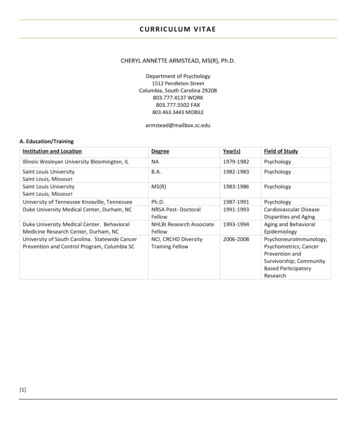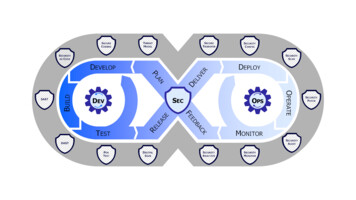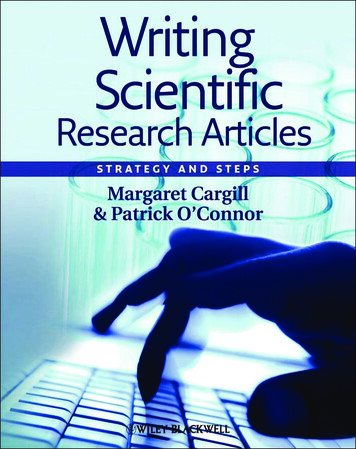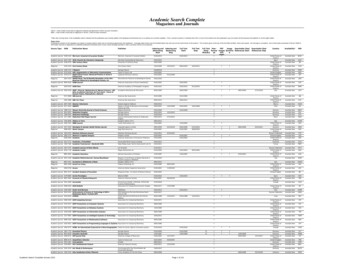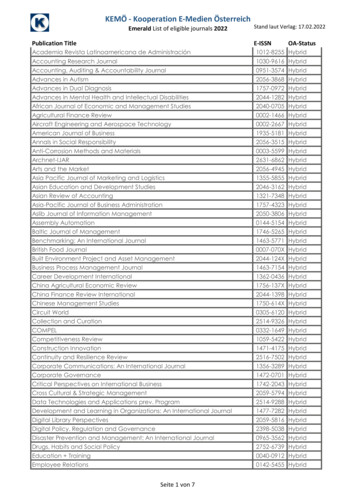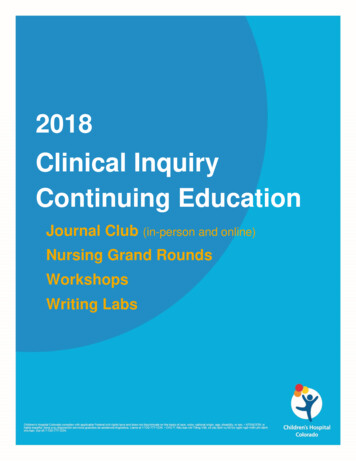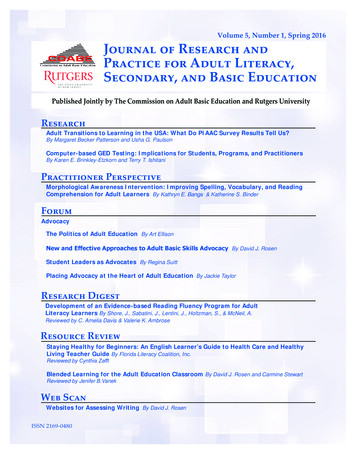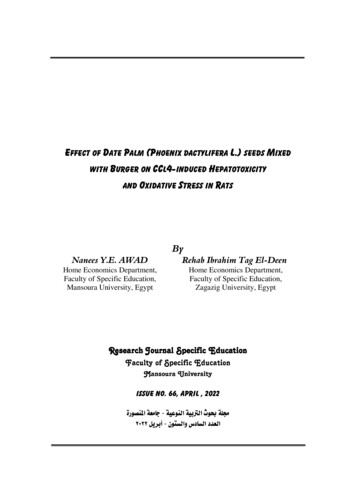
Transcription
EFFECT OF DATE PALM (PHOENIX DACTYLIFERA L.) SEEDS MIXEDWITH BURGER ON CCL4-INDUCED HEPATOTOXICITYAND OXIDATIVE STRESS IN RATSByNanees Y.E. AWADRehab Ibrahim Tag El-DeenHome Economics Department,Faculty of Specific Education,Mansoura University, EgyptHome Economics Department,Faculty of Specific Education,Zagazig University, EgyptResearch Journal Specific EducationFaculty of Specific EducationMansoura UniversityIssue No. 66, April , 2022@ @@ @ñŠì—ä¾a@òÈßbu@-@òîÇìäÛa@òîi Ûa@tì @òܪRPRR@Ýí‹ic@-@æìn Ûaë@‘†b Ûa@†‡ÈÛa
Effect of Date Palm (Phoenix dactylifera L.) seeds Mixed with Burger on CCl4-induced Hepatotoxicity758
٢٠٢٢ – ٦٦ א א – د EFFECT OF DATE PALM (PHOENIX DACTYLIFERA L.) SEEDS MIXEDWITH BURGER ON CCL4-INDUCED HEPATOTOXICITYAND OXIDATIVE STRESS IN RATSNanees Y.E. AWAD*Rehab Ibrahim Tag El-Deen**AbstractBackground: Date palm has been shown to have excellentantioxidant activity as a result of containing high flavonoids and phenolic. Ithas been cited in several studies for the treatment of liver problems, as wellas gastric and intestinal disorders. Aim of the study: The present study wasadministrated to inspect the hepatoprotective activity of burgers mixed withdate palm seeds on carbon tetrachloride (CCl4)-induced Hepatotoxicity inrats. Materials and Methods: Thirty-six rats were divided into two maingroups, the first group (n 6 rats) was G (1): control (-ve), rats of secondmain group (n 30 rats) were injected CCl4 twice a week for two weeks toinduce hepatotoxication. After that, divided into 5 groups (each 6 rats) asfollow: G (2): Hepatotoxicated rats as a control ( ve) and fed on basal dietonly. G (3): Injected rats by CCl4 were fed on basal diet with burgerscontrol, G (4, 5 and 6): Injected rats by CCl4 were fed on basal diet withburgers mixed with date palm seeds (10, 20 and 30g /kg), respectively.Results: Results demonstrated that burgers mixed with date seeds revealedsignificant improvement blood indicaors of CCl4-induced hepatotoxicatedrats, hemoglobin (HB) and packed cell volume (PCV), (AST, ALT andALP) liver function parameters. Also, both serum creatinine and uric acidlevels were significantly decreased and nitric oxide (NO). In addition, itrestored the antioxidant enzymes activities (glutathione S-transferase (GST),Catalase (CAT) and superoxide dismutase (SOD) that were deficient after*Professor of Nutrition and Food Science, Faculty of Specific Education, Department ofHome Economics,acting dean of Faculty Specific Education previously, DamiettaUniversity.**Assistant Professor of Nutrition and Food Science, Department of Home Economics,Faculty of Specific Education, Damietta University.759
Effect of Date Palm (Phoenix dactylifera L.) seeds Mixed with Burger on CCl4-induced HepatotoxicityCCl4 induction. Conclusions: The Date Palm (Phoenix dactylifera L.) seedsDM might be a promising alternative for CCl4-induced liver intoxicationprotection, and this hepatoprotective activity could be linked to antioxidantactivities. It can be utilized as a natural preservative additive in suggestiveformulations as a functional food and dietary supplement throughbiotechnological processes.Key words: Phoenix dactylifera L., polyphenols, antioxidant, CCL4and HepatotoxicityINTRODUCTIONThe Liver is vital organ responsible for metabolic processes.Hepatic damage is correlated to dysfunction of these metabolic processes.Liver dysfunction occurs mainly because of extreme consuming of alcohol,viral infections, xenobiotic exposure and medicine adverse effects ormedication interactions. The treatment of liver diseases is still a contentiousdiscussed topic (Kumar et al., 2011 and Kokhdan et al., 2017). Moreover,hepatotoxicity caused by drug-induced is common in developed countries,including Egypt, where people suffer from a variety of liver disorders(Omar et al., 2013). Drug induced liver damage is not preventable duringalong utilizing drugs in management of chronic diseases which isconsidered an absolute necessity, for example analgesic anti-inflammatoriesand anticonvulsants (Hong, 2019). Consequently, increasing liver cellrestoration through immune enhancement and avoiding the chain oxidationprocess as a contributor to liver injury is critical. The concept of employingnatural products as antioxidant supplements is based on the synergisticeffect of several different types of antioxidant components found in closelyrelated plants (Abdelaziz and Ali, 2014 and Koumbi, 2017).Liver damage induced by CCl4 (Carbon tetrachloride) is one of themost often used animal models for investigation of hepatoprotectiveefficiency of numerous substances (Cabre et al., (2000); Kokhdan et al.,2017; Erdemli et al., 2018 and Abu et al., 2021). It stimulated hepaticinjury through generating reactive oxidative stress by inducing reactiveoxidative stress via biological activation of the cytochrome P-450 system,760
٢٠٢٢ – ٦٦ א א – د which produces the toxic reactive trichloromethyl peroxyl radical, thisradical new attack on membrane lipids sets off a chain reaction results inmembrane lipid peroxidation, which causes hepatocellular damage andcarcinoma (Weber et al., 2003; Basu, 2003; Li et al., 2015 and Abu et al.,2021).Date palm seeds (DM) are a by-product that comes out in a greatamount during the date’s manufacture process (Al Farsi et al., 2005). Datefruits represent approximately 15% of the total weight of dates (Hussein etal., 1998), it is a good source of high nutritive value food as a result of itshigh content of fiber, minerals, vitamins, lipids and protein. Thephytochemical analysis of date palm showed the presence of qualitative andquantities of total polyphenolic compounds and flavonoids such as tanninsand anthraquinone glycoside, moreover, it has total polyphenol contenthigher than in the edible flesh. Therefore, it is believed that it has the abilityto restore liver cells and protect it due to containing high amounts ofpolyphenolic compounds and flavonoids (Al Farsi and Lee, 2008; Habiband Ibrahim, 2009; Habib et al., 2014A; Bentrad et al., 2017; Sundar etal., 2017; Metoui et al., 2019 and Chinelo et al., 2019). Conventionally, itused in traditional medicine as herbal medication because of its antidiabetic,antirhematic, choleretic, diuretic properties, gastrointestinal complaints,tumors and inflammation (Al-Showiman, 1990; Gogt, 2000 and Schütz etal., 2006). Recently, literatures have revealed that date can act asantioxidants, anti-cholesterol, anti-inflammatory, immune-stimulant,antihyperglycaemic and renoprotective effects (Saryono et al., 2018 and2019 and Alghamdi et al., 2020) .Hence the date palm seeds (Phoenix dactylifera L.) (DM) are asubstantial supply of biologically active constituents could be utilized as acomponent in meat products; Thus, burgers were mixed with dried dateseeds powder (0, 10, 20 and 30g/kg). This study aims to determine chemicalcomposition, phytochemical constituents of (DM), preserve burgers withDM and finally evaluate the protective ability of burgers mixed with palmdate seeds against CCl4-induced hepatotoxicity in experimental rats.761
Effect of Date Palm (Phoenix dactylifera L.) seeds Mixed with Burger on CCl4-induced HepatotoxicityMATERIALS AND METHODSMATERIALS Date palm seeds (Phoenix dactylifera L.) (DM) were collected as aby-product from Vitrac Food and Drink Company, Cairo, Egypt.Afterwards, DM was washed using tap water, then dried at (50 C)for a week in the oven. Afterwards, DM were crushed utilizing acommercial blender. It was ground and sieved until it became a finepowder. The beef meat was collected from local market Cairo, Egypt . Carbon tetrachloride (CCl4), as a toxic chemical substance for liverpoisoning, was purchased from El-Gomhouria Company for TradingGrugs, Chemicals and Medical Requirements, Cairo, Egypt(Passmore and Eastwood, 1986). Paraffin oil, for dilution during the induction, was purchased from apharmacy in the local marketMETHODS:Preparation of Beef Burger Formula:Beef Burger blend were prepared as describe by (Abd-Elhak et al.,2014) as follows: contained: 71.5, 7.0, 5.0, 5.0, 10.0, of and (g/100g mixedburger) of fat, fine ground onion, bread crust powder, whole egg, rehydratedsoy and salt, respectively. The mentioned constituents were minced anddivided into four equal quantities, as follows The first sample: control group (just the mixture of burger withoutadds). The second sample: mixed with DM (10 g /kg burger). The third sample: mixed with DM (20 g /kg burger). The fourth sample: mixed with DM (30 g /kg burger).Determination of chemical composition:Moisture content, crude protein, crude fiber, crude fat and ash of DMwere determined according to (AOAC 2007). Carbohydrates were alsocalculated by difference.762
٢٠٢٢ – ٦٦ א א – د Determination of total phenolic compounds:The phenolic compounds of DM were determined in DM ethanolicextract by HPLC according to Goupy et al., (1999) using HPLC HewlletPackered (series 1050) equipped.Preparation of beef burger for microbiological analysis:About 50g of beef burger were aseptically weighed and grinded insterilized hun. One gram of the grinded Beef Burger was transferred intoanother sterilized mortar for microbiological analysis where nine ml ofsterilized saline solution was added and thoroughly mixed with the beefburgers and this represents 10 dilutions which were then used makingfurther dilution according to Karpinska et al., (2001).Determination of total aerobic bacteria count:The aerobic and anaerobic plate count were determined followingthe procedure proposed by the International Commission onMicrobiological Specifications for Foods (ICMSF, 1987). This mediumwas obtained from El-Gomhouria Pharmaceutical Company Ameriea, Cairo,Egypt. Microbiological examination was carried out every seven daysinterval from storage at refrigerator temperature. All count were done intriplicates. At each sampling time, the stored bags were analyzedmicrobiologically according to the procedure recommended by (ICMSF,1987). Also, Serial dilutions were prepared as described by (ICMSF, 1987).Experimental animals and diet:Thirty-six rats weighing an average of (165 5g) were obtained fromThe Laboratory Animals of Helwan Farm. The animals were observed forfive days prior to the experiment and fed a standard diet and water adlibitum. The standard diet was performed according to NRC, (1995). Theethical conduct for use and care of animals in this research had beenapproved by the Research Ethics Committee.Experimental design:The experiment was performed in Animal House in the Institute ofpathology, Giza. Directly after adaptation, rats were divided into two main763
Effect of Date Palm (Phoenix dactylifera L.) seeds Mixed with Burger on CCl4-induced Hepatotoxicitygroups: The first group consisted of (n 6 rats) was fed on the basal dietonly and considered as negative control (C-ve) or normal rats. The mainsecond group of rats consisted of (n 30 rats) in which every rat wasinjected by 0.5 ml CCl4 diluted by paraffin oil 50 % (3 ml/kg of bodyweight), and to induce hepato-intoxicition, subcutaneous injection wasadministered by back twice a week in period of two weeks, according toJayasekhar et al., (1997). Then, blood samples were collected by themethod of hepatic portal vein to liver injury be ensured and liver functionsbe estimated. After that the rats were divided into 5 groups (6 rats each)beside the first group as follow: Group (1): The normal rats as a negative control (C -ve group)which feed on basal diet. Group (2): The hepato-intoxicated rats which kept without anytreatment and fed on basal diet. Group (3): Injected rats by CCl4 then fed on basal diet with burgerscontrol 10g Group (4): Injected rats by CCl4 then fed on basal diet with DMburgers 10g (10 g /kg) . Group (5): Injected rats by CCl4 then fed on basal diet with DMburgers 10g (20 g /kg) . Group (6): Injected rats by CCl4 then fed on basal diet with DMburgers 10g (30 g /kg) .Blood sampling:At the end of the experiment, all the rats’ groups were sacrificed andblood samples were collected. Blood mixed with heparin was analyzed for(HB) hemoglobin and (PCV) packed cell volume determination according toDrabkin (1949) and Mc Inory, (1954), respectively .According to Reitman and Frankel (1957); Kind and King(1954); Hare (1950) and Fossati et al., (1980) serum alanine transaminase(ALT), (AST) aspartate aminotransferase, alkaline phosphates enzymes(AP), creatinine and uric acid were determined, respectively.764
٢٠٢٢ – ٦٦ א א – د According to Habig (1974), Claiborne (1985); Beuchamp andFridovich, (1971) and Green et al., (1981), respectively, (GST) Plasmaglutathione transferase, catalase, (SOD) superoxide dismutase enzymes and(NO) nitric oxide were determined.Statistical analysis:As reported by Snedecor and Cochran ( 1967), Dunnet’s t-testwere used for the analyzation of Differences between groups followed bysignificant indication analysis of variance (ANOVA) between differentgroups.RESULTS AND DISCUSSIONChemical composition of date palm seeds and burgers mixed with DMThe proximate chemical composition of DM and burgers mixedwith DM (0, 10, 20 and 30g/kg burger) are presented in Table 1. Themoisture, fat, protein, ash and carbohydrates % content of date DM were3.44, 1.17, 5.98, 1.79 g and 87.62, respectively. It could be observed that theaddition of palm to burgers result in increment of moisture, fat, protein andash content when compared to the control burger. Such values are kind ofconsistent with those mentioned by Al-farsi et al., (2007) who estimated theOmani varieties date palm’ chemical composition as 3.1–7.1%, 2.3–6.4%,5.0–13.2%, 0.9–1.8% and 22.5–80.2% of moisture, protein, fat, ash anddietary fiber, respectively. However, the chemical composition of date seedswas reported as 16.06 - 33.61%, 5.23-7.02%, 4.88-7.81% and 73.83-82.3%of Moisture, protein, fat and Dietary fiber, respectively (Metoui et al.,2019).Table (1): Chemical composition of date palm seeds and burgers mixed e palm3.441.175.981.7987.62burger control 0% DM11.5010.0822.711.4554.26burgers with 10%DM19.4312.4727.772.0238.31burgers with 20%DM17.8916.6039.252.7623.50burgers with 30%DM12.8920.6034.252.9829.28765
Effect of Date Palm (Phoenix dactylifera L.) seeds Mixed with Burger on CCl4-induced HepatotoxicityPhytochemical constituents of date palm seeds ethanolic extractDM ethanolic extract showed the presence of various qualitative andquantities of polyphenolic compound table (2). The preliminaryphytochemical investigation stated that it included significant amounts ofvanillic, catechol, pyrogallol, protocatchchuic, epicatechein, e-vanillic, poh-benzoic, gallic, ellagic, salicylic, chlorogenic, catechein and caffeine,respectively. These results were consistent with Abdelaziz and Ali (2014)who reported that (Phoenix dactylifera L.) had high quantities of phenoliccompounds (38.8 mg gallic acid equivalent g-1) and total flavonoids (87.86mg rutin equivalent/g). Also, several reports stated that, date palm DM havelarge variables of antioxidants (phenolics and flavonoids) (Al-Farsi et al.,2007; Al-Farsi and Lee, 2008 and Juhaimi et al., 2012). Al-Farsi et al.,(2007) and Habib et al. (2014 B) revealed that date palm is a rich source ofpolyphenolic compounds more than grapes, flaxseed, nut DM in comparisonand even date fruit; thus, DM could be benefitial in functional foodprospects. The flavan-3-ols representing the main class in almost percentage99% of total polyphenolic compounds and were distributed as epicatechinand catechin. According to Ardekani et al. (2010) it could be utilized inmedicinal as well as commercial fields for benefits as containing highamounts of antioxidant (37.42 mmol FeⅡ /100 g dry plant) and (3541 mggallic acid/100 g dry plant) as aphenolic content. Gallic acid, m-coumaricacid and p-hydroxybenzoic acid have been identified in date DM as same asvanillic acid protocatechuic acid and p-coumaric acid, besides ferulic acid,caffeic acid and o-coumaric acid (Al-Farsi and Lee, 2008). Bijami et al.,(2020) identified six compounds which were gallic acid, chlorogenic acid,p-coumaric acid, sinapic acid, catechin, and vanillin as noticed andenumerated by HPLC during analysis of palm DM.766
٢٠٢٢ – ٦٦ א א – د Table (2): Phytochemical constituents of date palm seeds extractphenolic compounddate palm extract ( nillic12819.49Ferulic126.40Iso- 393.953,4,5Methoxy cinnamic9.01Coumarin56.95p- coumaric102.18Cinnamic1.77Determination of total aerobic bacteria count during storage period ofburgers mixed with DMThe antibacterial (preserving) properties of studied burgers mixedwith DM (0, 10, 20 and 30g/kg) against total aerobic bacteria is presented inTable 3. The data showed that there was high influence on the burgersantibacterial activity caused by DM quantities and storage period as it767
Effect of Date Palm (Phoenix dactylifera L.) seeds Mixed with Burger on CCl4-induced Hepatotoxicityincreased by increasing the amount of DM powder and storage period. Thiswas confirmed by the count of total aerobic bacteria.The represented results are consistent with Metoui et al., (2019)and Radfar et al., (2020) who stated that DM have antimicrobialproperties, especially against Gram-positive bacteria. Radfar et al., (2019)revealed that DM extract included inhibitory effects against Staphylococcusaurous. The antibacterial efficiency of date extracts could be attributed tothe presence of phenolic compounds and polyphenols during the proteinprecipitation process, as well as an inhibitory effect on microorganismenzymes (Metoui et al., 2019). Recently, there were high increment inutilizing natural additive preservatives particularly from plant sources, as aresult of the undesirable consequences of utilizing chemical preservativeadditives in the production of preserved foods (Mir et al., 2018).Table (3): Determination of total aerobic bacteria count during burger storageperiodStorage periodZero time7 days15 days30 daysControl burger4 106 a7.3 106 c13.6 106 c15 106 cBurger preserved using DM (10 g /kg).1 106 b1.6 106ab1.3 106 a9 105abBurger preserved using DM (20 g /kg).2 106 b1 106 a3 105 b6 105 aBurger preserved using DM (30 g /kg).2 106 b1 106 a1 106 a1 106 bEach value represents the mean SD. Means in the same raw withdifferent superscript letters were significant different at P 0.05.Effect of burgers mixed with date palm seeds on body weight, bodyweight gain, food intake and feed efficiency ratio (FER)The body weight gain, food intake and feed efficiency ratio (FER)of all studied groups are shown in Table (4). Growth indicator of theexperimental groups was performed according to the body weight gain justas the experiment ended. Administration of CCl4 for two weeks reduced theweight gain significantly (54.30 g) in (C ve) group in comparison with the(C-ve) group (85.92g). The rats of group (3) injected by CCl4 then fed withthe basal diet with burgers control gained more weight as compared to CCl4768
٢٠٢٢ – ٦٦ א א – د group but fewer than the control group. However, rats of groups (4, 5 and 6)injected by CCl4 and then with the basal diet and burgers mixed with DM(10, 20 and 30 g/kg, respectively) markedly improved the growthperformance. Regarding food intake, it could be noted that there were nosignificant changes between all treatment as compared to negative control.Meanwhile, feed efficiency ratio (FER) for positive control (G2)significantly decreased compared to control group and all treatment groups.This comes in accordance with Abdelaziz and Ali (2014) who reported that(Phoenix dactylifera L.) DM caused weight gain significantly increased incomparison with CCl4 group. On the contrary, non-significant differences inrats’ body weight revealed in-between the experimental (normal, CCl4treated only and pre-treated with plant extracts then after-treated with CCl4)groups (Thanebal et al., 2021).Table (4): Effect of burgers mixed with date palm seeds on body weight, bodyweight gain, food intake and feed efficiency ratio ControlburgerBurger gInitialWeightFoodIntake(g/d))115.55 3.17a16.15 2.11 a110.41 2.50 a14.58 2.17 a113.14 3.45 a16.12 2.11 a112.33 2.99 a16.25 2.91 a110.22 3.11 a16.65 2.18 a110.34 3.14 a16.25 2.81 aFinalWeight(g)200.47 10.11 a155.71 15.6b**174.71 10.9 a190.3 13.80 a205.5 12.00 a203.44 15.8 aWeightGain(g)85.92 11.33 a54.30 7.71 b**75.57 8.17 a88.08 10.22 a95.92 11.11 a93.77 11.21 aFER0.093 0.001 a0.051 0.002 b**0.084 0.003 a0.092 0.001 a0.091 0.001 a0.094 0.003 aEach value represents the mean SD. Means in the same raw withdifferent superscript letters were significant different at P 0.05.769
Effect of Date Palm (Phoenix dactylifera L.) seeds Mixed with Burger on CCl4-induced HepatotoxicityEffect of burgers mixed with date palm seeds on blood hemoglobin(HB) and packed cell volume (PCV) on rats intoxicated by CCL4From the obtained results, it could be observed that rats fed oncontrol burgers and burgers mixed DM produced significant increase in(HB) values and (PCV) compared to positive control group (table 5).Meanwhile, non-significant changes revealed in-between control burgersand burgers mixed with DM treatment groups and negative control group.These results were in agreement with Orabi and Shawky (2014) whoindicated that date caused significant increase in HG concentration,meanwhile, PCV%, WBCS% and RBCs% didn’t record significantdifferences in-between the groups date and control which received basaldiet.Table (5): Effect of burgers mixed with date palm seeds on blood hemoglobin(HB) and packed cell volume ControlburgerBurger usingDM10g/kgburger usingDM20g/kgburger usingDM30g/kgHB(gm/dl)13.39 1.18 a6.19 0.39 b**11.54 1.4 a10.95 1.98 a12.18 2.01 a12.54 1.82 aPCV%40.01 3.82 a29.91 3.55b*34.79 3.47 b*35.24 4.01 a b36.61 4.11 a36.91 3.17 aEach value represents the mean SD. Means in the same raw withdifferent superscript letters were significant different at P 0.05.Effect of burgers mixed with date palm seeds treatment on liver andkidney functionsLiver and kidney parameters investigated in this research arerepresented in Table 6. It could be noted that induction with CCl4 for 2weeks generated abnormal liver indicators as revealed by increment ofserum values of hepatic enzymes AST, ALT and ALP. As well as, whencompared to the control group, serum creatinine and uric acid levelsincreased significantly. However, administration of burgers mixed with DMretrieved normal levels of ALT, AST and ALP as compared to the CCl4770
٢٠٢٢ – ٦٦ א א – د group, while caused a significant decrease in serum creatinine and uric acidlevels in comparing with the same group. Additionally, the maximumenhancement of liver and kidney functions accomplished in group (6).Reduction of CCl4-induced in animals treated with burgers mixed with DMenhanced the activities of AST, ALT and ALP levels showing their impacton restoring normal liver functions that been poisoned, and protectingagainst consequences of CCl4 hepatotoxicity.There are firm evidences in scientific research which indicated thatCCl4 conduction induces hepatic injury experimented on animals revealedincrement of serum levels of ALT, AST and ALP (Al-Qarawi et al., 2004;Abdelaziz and Ali, 2014; Liu et al., 2018; Rizk et al., 2020; Abu et al.,2021 and Thanebal et al., 2021). Abdelaziz and Ali (2014) stated thatusing either the raw (Phoenix dactylifera L. DM) or the roasted significantlyreduced the CCl4-induced increments of liver function indicators in serumblood (GOT, GPT and ALP). Moreover, Ahmed et al., (2015) showed thatCCl4 induced mice revealed an increase in free radicals leading to kidneyand liver injury. On the other hand, giving DM extract reduced levels ofALT, AST, ALP and creatinine and increased the body's antioxidant ability(Al meqbaali et al., 2017). The reducing levels of these indicators ascompared to the normal control values is evident on the stability of plasmamembranes besides the liver damage restoration. Kowalska et al., (1990)mentioned that (Phoenix dactylifera L.) date’s high content of flavonoidscould be contributing element besides its hepatoprotective efficiencythrough cytochrome P-450 aromatase inhibition. Khan et al., (2018) statedthat in mice suffering from hyperlipidemia, the mice consumed Ajwa extractrevealed ALT and AST values were higher as compared to the treated micewith atorvastatin only. Alghamdi et al., (2020) reported that as compared tothe ischemia/reperfusion (I/R) injury group, date palm extract resulted insignificant reductions in serum creatinine and uric acid levels.771
Effect of Date Palm (Phoenix dactylifera L.) seeds Mixed with Burger on CCl4-induced HepatotoxicityTable (6): Effect of burgers mixed with date palm seeds treatment on liverand kidney controlG2ControlburgerG3Burger usingDM10g/kgG4burger usingDM20g/kgG5burger usingDM30g/kgG6AST(µ /ml)ALT(µ /ml)Alk –Pho(µ /ml)Creatinine(mg/dl)Uric acid(mg/dl)46.17 5.81b13.35 1.12b32.17 5.66 b0.78 0.01b1.83 0.26c77.39 9.61 a**28.55 3.35 a**50.38 5.81 a**1.96 0.11 a**4.41 1.01 a***48.37 6.01 b16.71 1.81 b39.80 4.11 b0.98 .02b2.11 0.81b*52.14 8.10 b49.21 6.15 b42.21 4.13 b15.28 2.01 b15.13 3.51 b14.11 3.65 b37.73 4.37 b36.34 5.01 b35.11 3.11 b0.88 0.12 b0.75 0.13 b0.74 0.15 b2.52 0.77 b*2.29 0.67 b*1.95 0.74 cEach value represents the mean SD. Means in the same raw withdifferent superscript letters were significant different at P 0.05.Effect of burgers mixed with date palm seeds treatment on antioxidantenzymes levels (glutathione S-transferase (GST), Catalase andsuperoxide dismutase (SOD) and nitric oxide (NO)As shown in Table 7, CCL4 administration caused an elevation ofnitric oxide (NO) level and a demotion in glutathione S-transferase (GST),Catalase (CAT) and superoxide dismutase (SOD) compared to the controlgroup. However, all groups treated with burgers mixed with DM restorednormal levels of GST, Catalase and SOD and caused significant decrease innitric oxide (NO) levels compared to CCl4 group. These results isagreement with Liu et al., (2018); Rizk et al., (2020); Abu et al., (2021)and Thanebal et al., (2021) established that the administration of CCL4affected antioxidant enzymes (SOD, CAT and Glutathione peroxidase(GPx)) by decreasing their activities in liver tissue homogenatesignificantly, in contrast, the oxidative stress parameter Malonyl-diAldehyde (MDA) value in the homogenate was significantly increased.Malondialdehyde level (as a reactive substance of thiobarbituric acid) andendogenous antioxidant enzymes activities such as SOD, GPx and CAT aresensitive indices in free radical induced hepatocellular damage (Mohajeri etal., 2011). Moreover, Abu et al., (2021) indicated that a significant decrease772
٢٠٢٢ – ٦٦ א א – د of SOD, GPx and CAT in the hepatic tissues of rats induced by CCl4 mayhave been caused by high amounts of free radicals produced by CCl4 andpossibly developed inactivation or inhibition of the synthetic pathways ofthese endogenous antioxidant enzymes thereby resulting in their lowturnover. Abdelaziz and Ali (2014) and Ahmed et al., (2015) establishedthat rats fed on an experimental diet contained (Phoenix dactylifera L.) DMpowder resulted in higher levels of both SOD and GST besides NO levelsignificantly decreased compared to CCl4 group in experimental rats. Theseindications showed that (Phoenix dactylifera L.) DM have antioxidantcompound that controlled the CCl4-induced oxidative stress in liver tissues.Also, these results agree with Paranthaman et al., (2012) who revealedthat flavonoid contents of (Phoenix dactylifera L.) DM have antioxidantproperties. Phytochemicals such as phenolic acid and flavonoid may haveantioxidant properties against the alterations of superoxide and hydroxidefree radicals, as well as hydrogen peroxide, restoring the antioxidant statusin the cells. (Etim et al., 2008). Alghamdi et al., (2020) stated that pretreatment utilizing date palm fruit or date palm extracts resulted insignificant increase in CAT activity and GSH concentration .Table (7): Effect of burgers mixed with date palm seeds treatment onantioxidant enzymes levels (glutathione S-transferase (GST),Catalase and superoxide dismutase (SOD) and nitric oxide lburgerG3Burger usingDM10g/kgG4burger usingDM20g/kgG5burger usingDM30g/kgG6Catalase (µ/l)SOD (µ /l)288.31 33.27 a285.21 55.14 a70.13 5.22 a240.21 23.71 a277.11 30.91 a71.31 9.23 a278.15 31.71a284.11 39.11a73.14 7.81 a2.17 0.33 b188.35 22.17 b*230.77 32.11 ab63.14 7.16a4.33 1.11 b211.31 23.81b*291.61 31.61a68.33 6.35 aNO (µmol /l)77.85 8.40c***102.55 10.14 c***46.25 3.47b***10.11 1.44a***3.22 1.03 b3.11 1.05 b2.01 1.21 bVariablesGST (µ /l)Each value represents the mean SD. Means in the same raw withdifferent superscript letters were significant different at P 0.05.773
Effect of Date Palm (Phoenix dactylifera L.) seeds Mixed with Burger on CCl4-induced HepatotoxicityConclusionsIn conclusion, the alimentation on burgers mixed and preservedwith date palm seeds might be considered as a nutritive source rich innatural fibers and phytochemicals and could be a valuable approach to avoidthe hepatotoxicity stimulates by carbon tetrachloride. These protectivecapabilities could b
Faculty of Specific Education, Mansoura University, Egypt Home Economics Department, . Research Journal Specific EducationResearch Journal Specific Education Faculty of Specific Education Mansoura University Issue No. 66, April , 2022 . used in traditional medicine as herbal medication because of its antidiabetic, antirhematic, choleretic .



